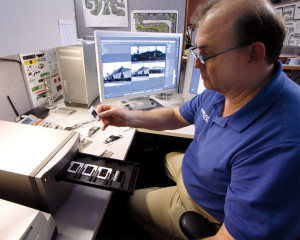Dale Kraus
CONTROL VARIABLES (CVs): What you need to know (and don’t)
A continuing source of confusion in the DCC world is the nature and use of Control Variables. There is a dizzying array of them, 248 at last count, so it’s easy for both novice and experienced DCC users to get a bit overwhelmed. Adding to the confusion, beyond the basic CVs not all decoder manufacturers use them in the same way (!?). That’s the bad news. The good news: You can have a smoothly operating, fully functional DCC railroad with realistic motion and speed matched locomotives, and only use seven CVs!
Note: For now use 28 speed steps, not 128. Trust me…it’s easier this way.
CV 1. Engine address. This one is obvious. Simply enter the locomotive number (up to 127) in this CV and sent it to the decoder, using whatever method your system recommends… that’s it! If you wish to have a four-digit address, go to Direct Programming in your system and bring up ADR. (Some systems will say Loco Num.) Punch in the digits and enter.
CV 2. Start voltage. This sets the decoder so the loco will start creeping as soon as you crack the throttle. Enter a low value here (1 or 2) and place the loco on an operating track. Bring up the address and open the throttle. If the loco doesn’t move by speed step 3 (out of 28) go back to programming mode and increase the value by 3. Usually this will do it. Older locos with open frame motors may require a higher starting voltage. Just fiddle with the numbers until it starts slowly.
CV 3. Acceleration. This CV adds simulated mass to the loco, enabling it to start like it weighs many tons instead of a few ounces. The higher the value entered here the slower the loco will accelerate. My experience with this CV is that a value between 8 and 12 is usually sufficient. More than this and the loco will start way too slowly.
CV 4. Deceleration. Another mass simulator. This CV allows the loco to drift realistically when braking to a stop. For most model railroads, a deceleration rate of about 6 to 8 is adequate. More than this, and your crack express will sail right past the station platform. (Ask me how I know this!) A caveat here: If you are doing a lot of switching, it is best to set the deceleration to 1 or 2. Too much braking delay makes accurate spotting and uncoupling of cars difficult.
CV 5. Maximum Speed. Almost all model locomotives run much too fast. Since we’re not running slot cars, we need to dramatically lower the top speed of our locos. This can get complicated, but, as a rule of thumb, set this value initially to 30 for conventional steam and diesels and 12 for geared steam locos. After you have done this, you can tweak this value up or down for each of your locos until they all run at close to the same speed for a given throttle setting.
CV 6. Medium Speed. Set this CV to about 1¤3 the value of CV 5. This will give you a very nice acceleration curve. Tweak as necessary later.
CV 29. Configuration. This can be a confusing CV if you think about it too much. However, all you need to remember are a few simple things. First, enter a value of 6 into this CV. If the loco runs in reverse when the throttle is set to run it forward, change this value to 7. That’s all, folks! A note here: if you are running permanently coupled F or E “A” units, with or without intervening “B”’s, pick one as the “lead” and enter 6 in CV 29. The other is the “trail” and should be given a value of 7.
That’s it for now. Next time we’ll tackle the dreaded consisting conundrum.


